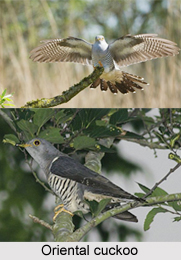 Oriental Cuckoo or Horsfields Cuckoo is an Indian bird that bears scientific name "Cuculus optatus" and belongs to the family of Himalayan cuckoo species.
Oriental Cuckoo or Horsfields Cuckoo is an Indian bird that bears scientific name "Cuculus optatus" and belongs to the family of Himalayan cuckoo species.
Category of Oriental Cuckoo
Oriental Cuckoo is a bird belonging to the genus Cuculus in the cuckoo family Cuculidae. It was formerly classified as a subspecies of the Himalayan cuckoo with the name Oriental cuckoo used for the combined species. Differences in voice and size suggest that they should be treated as a separate species. The binomial name Cuculus horsfieldi has often been used instead of Cuculus optatus but is now usually considered to be a junior synonym.
Structure of Oriental Cuckoo
Oriental Cuckoo is 30-32 centimetres long with a wingspan of 51-57 centimetres and a weight of 73-156 grams. The adult male has a grey head, breast and upperparts. The belly is creamy-white with dark bars. The vent is frequently buff with few markings. The legs and feet are orange-yellow and there is a bare yellow ring around the eye. Adult females and juveniles occur in two morphs.
Colour of Oriental Cuckoo
Oriental Cuckoo has the grey morph that is similar to the male but has a brownish wash on the breast. The rufous morph is reddish-brown above, paler on the under parts and with strong dark barring all over including the rump.
Wings of Oriental Cuckoo
Common Cuckoo is very similar in appearance but is slightly bulkier with longer wings and tail and a slightly smaller head and bill. It is slightly paler grey and the barring on the under parts is a little narrower. The vent of Oriental Cuckoo is usually white with dark bars but is more similar to Oriental cuckoo in a few individuals. The birds of the rufous morph have a plain rump with no dark bars unlike the Oriental cuckoo. Himalayan cuckoo is extremely similar to the Oriental cuckoo but is slightly smaller and shorter-winged.
Sounds of Oriental Cuckoo
The sound of the male Oriental Cuckoo is a series of low paired notes, poo-poo, with both notes stressed equally. It is somewhat similar to the call of the Hoopoe. It may be introduced with a four to eight note phrase or sometimes with grating notes. The female`s call is a deep bubbling trill.
Behaviour of Oriental Cuckoo
Oriental Cuckoo birds are usually silent. The call of the male Himalayan Cuckoo is a series of three or four note phrases with a short, high-pitched introductory note
 Breeding Season of Oriental Cuckoo
Breeding Season of Oriental Cuckoo
Oriental Cuckoo has a large breeding range in northern Eurasia. It breeds across much of Russia west to the Komi Republic with occasional records as far west as Saint Petersburg. It also breeds in northern Kazakhstan, Mongolia, northern China, Korea and Japan. There have been records of birds displaying in Finland in recent years but their identification is no longer considered certain. The exact extent of its wintering range is uncertain due to its secretive habits and the difficulty of separating it from the Himalayan cuckoo and other similar species.
Nests of Oriental Cuckoo
Oriental Cuckoo mainly inhabits forests, occurring in coniferous, deciduous and mixed forest. It feeds mainly on insects and their larvae, foraging for them in trees and bushes as well as on the ground.



















